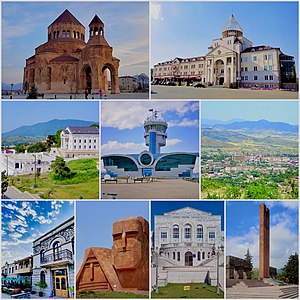
Back Степанакерт Abkhazian Stepanakert Afrikaans Stepanakert AN خانكندي Arabic خانكندى (مدينه فى شوشينسكى ويزد) ARZ Stepanakert AST Xankəndi Azerbaijani خانکندی AZB Xankəndi BAR Ханкэнды Byelorussian
Parts of this article (those related to the Artsakh era) need to be updated. (October 2023) |
Stepanakert / Khankendi
Ստեփանակերտ Xankəndi | |
|---|---|
 From top left: Holy Mother of God Cathedral Renaissance Square • Downtown Stepanakert Stepanakert Airport • Stepanakert skyline Park Hotel Artsakh • We Are Our Mountains Artsakh University • Stepanakert Memorial | |
Location of Stepanakert/Khankendi in Azerbaijan and its Karabakh Economic Region. | |
| Coordinates: 39°48′55″N 46°45′7″E / 39.81528°N 46.75194°E | |
| Country | Azerbaijan |
| Region | Karabakh |
| City status | 1940[1] |
| Area | |
| • Total | 29.12 km2 (11.24 sq mi) |
| Elevation | 813 m (2,667 ft) |
| Population (2021)[2] | |
| • Total | 75,000 |
| • Density | 2,600/km2 (6,700/sq mi) |
| Time zone | UTC+4 (GMT+4) |
| Area code | +994 26 |
| Sources: Stepanakert city area and population[3] | |
Stepanakert (Armenian: Ստեփանակերտ, romanized: Step'anakert, Eastern pronunciation: [stɛpʰɑnɑˈkɛɾt]) or Khankendi (Azerbaijani: Xankəndi, pronounced [xɑnkænˈdi] ⓘ) is a ghost city[a] in the Nagorno-Karabakh region of Azerbaijan. The city was under the control and the capital city of the breakaway Republic of Artsakh prior to the 2023 Azerbaijani offensive in the region. The city is located in a valley on the eastern slopes of the Karabakh mountain range, on the left bank of the Qarqarçay (Karkar) river.[8]
The area that would become Stepanakert was originally an Armenian settlement named Vararakn.[9] During the Soviet period, the city was made the capital of the Nagorno-Karabakh Autonomous Oblast, becoming a hub for economic and industrial activity.[1] In addition, the city became a hotbed for political activity, serving as the center for Armenian demonstrations calling for the unification of Nagorno-Karabakh with Armenia. Stepanakert suffered extensive damage following the dissolution of the Soviet Union and the outbreak of the First Nagorno-Karabakh War and passed into the hands of local Armenians with the establishment of the Republic of Artsakh.
During the control by the Armenians, the city was a regional center of education and culture, being home to Artsakh University, musical schools, and a palace of culture. The economy was based on the service industry and had varied enterprises, food processing, wine making, and silk weaving being the most important.[8] As of 2021, the population of Stepanakert was 75,000.[10]
On 29 September 2023, Azerbaijani authorities took control of the city, with almost the entire Armenian population fleeing to Armenia ahead of their advancing forces.[11]
- ^ a b Hewsen 2001, p. 265
- ^ "Figures" (PDF). stat-nkr.am. 2015. Archived (PDF) from the original on 12 September 2020. Retrieved 12 April 2016.
- ^ "General Characteristics of the NKR" (PDF). Archived (PDF) from the original on 29 September 2015. Retrieved 16 September 2015.
- ^ "Nagorno-Karabakh's abandoned capital transforms under Azerbaijani rule". Eurasianet. 11 January 2024. Retrieved 2 February 2024.
It was once the seat of a de facto government. Now it's a ghost town that plays host to projections of its conquerors' power
- ^ Nechepurenko, Ivan (17 November 2023). "What's Left When a Long War Suddenly Ends". The New York Times. ISSN 1553-8095.
…the Nagorno-Karabakh city of Stepanakert, also known as Khankendi, a ghost town after its ethnic Armenian residents fled in fear as Azerbaijani troops captured the area.
- ^ Barseghyan, Arshaluys; Aghayev, Ismi (2 October 2023). "UN mission arrives to empty streets in Nagorno-Karabakh". OC Media.
Reporting from the regional capital Stepanakert, Al Jazeera describes a 'ghost town' with no one left.
- ^ Gunter, Joel (3 October 2023). "Deserted Nagorno-Karabakh reveals aftermath of lightning-fast Armenian defeat". BBC.
The few images that have emerged from Khankendi since the takeover show a ghost town, where possessions appear to have been abandoned in the streets as residents fled.
- ^ a b Baranchikov 2016, p. 225
- ^ Cite error: The named reference
Vararaknwas invoked but never defined (see the help page). - ^ Khachatryan, Karen (13 August 2021). Stepan Kocharyan (ed.). "Drought leads to "unprecedented" water crisis in Stepanakert city". armenpress.am. Stepanakert: Armenpress. Archived from the original on 2 July 2022. Retrieved 18 December 2021.
- ^ "Armenians describe journey to safety after fall of their homeland". The Independent. 29 September 2023. Archived from the original on 30 September 2023. Retrieved 30 September 2023.
Cite error: There are <ref group=lower-alpha> tags or {{efn}} templates on this page, but the references will not show without a {{reflist|group=lower-alpha}} template or {{notelist}} template (see the help page).
© MMXXIII Rich X Search. We shall prevail. All rights reserved. Rich X Search

